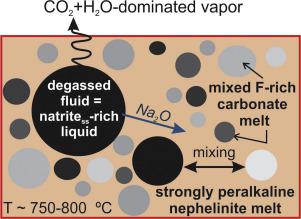当前位置:
X-MOL 学术
›
Gondwana Res.
›
论文详情
Our official English website, www.x-mol.net, welcomes your
feedback! (Note: you will need to create a separate account there.)
Carbonatite and highly peralkaline nephelinite melts from Oldoinyo Lengai Volcano, Tanzania: The role of natrite-normative fluid degassing
Gondwana Research ( IF 7.2 ) Pub Date : 2020-09-01 , DOI: 10.1016/j.gr.2020.03.013 Márta Berkesi , Enikő Bali , Robert J. Bodnar , Ábel Szabó , Tibor Guzmics
Gondwana Research ( IF 7.2 ) Pub Date : 2020-09-01 , DOI: 10.1016/j.gr.2020.03.013 Márta Berkesi , Enikő Bali , Robert J. Bodnar , Ábel Szabó , Tibor Guzmics

|
Abstract Oldoinyo Lengai, located in the Gregory Rift in Tanzania, is a world-famous volcano owing to its uniqueness in producing natrocarbonatite melts and because of its extremely high CO2 flux. The volcano is constructed of highly peralkaline [PI = molar (Na2O + K2O)/Al2O3 > 2–3] nephelinite and phonolites, both of which likely coexisted with carbonate melt and a CO2-rich fluid before eruption. Results of a detailed melt inclusion study of the Oldoinyo Lengai nephelinite provide insights into the important role of degassing of CO2-rich vapor in the formation of natrocarbonatite and highly peralkaline nephelinites. Nepheline phenocrysts trapped primary melt inclusions at 750–800 °C, representing an evolved state of the magmas beneath Oldoinyo Lengai. Raman spectroscopy, heating-quenching experiments, low current EDS and EPMA analyses of quenched melt inclusions suggest that at this temperature, a dominantly natritess-normative, F-rich (7–14 wt%) carbonate melt and an extremely peralkaline (PI = 3.2–7.9), iron-rich nephelinite melt coexisted following degassing of a CO2 + H2O-vapor. We furthermore hypothesize that the degassing led to re-equilibration between the melt and liquid phases that remained and involved 1/ mixing between the residual (after degassing) alkali carbonate liquid and an F-rich carbonate melt and 2/ enrichment of the coexisting nephelinite melt in alkalis. We suggest that in the geological past similar processes were responsible for generating highly peralkaline silicate melts in continental rift tectonic settings worldwide.
中文翻译:

来自坦桑尼亚 Oldoinyo Lengai 火山的碳酸岩和高碱性霞石熔体:钠长石标准流体脱气的作用
摘要 Oldoinyo Lengai 火山位于坦桑尼亚的格雷戈里裂谷,因其独特的碳酸盐岩熔体产生和极高的 CO2 通量而闻名于世。火山由高碱性 [PI = 摩尔 (Na2O + K2O)/Al2O3 > 2–3] 霞石和响岩构成,这两种物质在喷发前都可能与碳酸盐熔体和富含 CO2 的流体共存。对 Oldoinyo Lengai 霞石的详细熔体包裹体研究结果提供了对富 CO2 蒸汽脱气在碳酸钠和高碱性霞石形成中的重要作用的见解。霞石斑晶在 750-800 °C 捕获了初级熔体包裹体,代表了 Oldoinyo Lengai 下方岩浆的演化状态。拉曼光谱,加热淬火实验,对淬火熔体夹杂物的低电流 EDS 和 EPMA 分析表明,在该温度下,主要是亚硝酸盐标准的、富含 F(7-14 wt%)的碳酸盐熔体和极度偏碱性(PI = 3.2-7.9)、富含铁的霞石在 CO2 + H2O 蒸汽脱气后,熔体共存。我们进一步假设脱气导致残留的熔体和液相之间重新平衡,并且涉及 1/ 残留(脱气后)碱金属碳酸盐液体和富含 F 的碳酸盐熔体之间的混合和 2/ 共存的霞石熔体的富集在碱中。我们认为,在过去的地质过程中,类似的过程是在全球大陆裂谷构造环境中产生高碱性硅酸盐熔体的原因。富氟 (7–14 wt%) 碳酸盐熔体和极度高碱性 (PI = 3.2–7.9)、富含铁的霞石熔体在 CO2 + H2O 蒸汽脱气后共存。我们进一步假设脱气导致残留的熔体和液相之间重新平衡,并且涉及 1/ 残留(脱气后)碱金属碳酸盐液体和富含 F 的碳酸盐熔体之间的混合和 2/ 共存的霞石熔体的富集在碱中。我们认为,在过去的地质过程中,类似的过程是在全球大陆裂谷构造环境中产生高碱性硅酸盐熔体的原因。富氟 (7–14 wt%) 碳酸盐熔体和极度高碱性 (PI = 3.2–7.9)、富含铁的霞石熔体在 CO2 + H2O 蒸汽脱气后共存。我们进一步假设脱气导致残留的熔体和液相之间重新平衡,并且涉及 1/ 残留(脱气后)碱金属碳酸盐液体和富含 F 的碳酸盐熔体之间的混合和 2/ 共存的霞石熔体的富集在碱中。我们认为,在过去的地质过程中,类似的过程是在全球大陆裂谷构造环境中产生高碱性硅酸盐熔体的原因。我们进一步假设脱气导致残留的熔体和液相之间重新平衡,并且涉及 1/ 残留(脱气后)碱金属碳酸盐液体和富含 F 的碳酸盐熔体之间的混合和 2/ 共存的霞石熔体的富集在碱中。我们认为,在过去的地质过程中,类似的过程是在全球大陆裂谷构造环境中产生高碱性硅酸盐熔体的原因。我们进一步假设脱气导致残留的熔体和液相之间重新平衡,并且涉及 1/ 残留(脱气后)碱金属碳酸盐液体和富含 F 的碳酸盐熔体之间的混合和 2/ 共存的霞石熔体的富集在碱中。我们认为,在过去的地质过程中,类似的过程是在全球大陆裂谷构造环境中产生高碱性硅酸盐熔体的原因。
更新日期:2020-09-01
中文翻译:

来自坦桑尼亚 Oldoinyo Lengai 火山的碳酸岩和高碱性霞石熔体:钠长石标准流体脱气的作用
摘要 Oldoinyo Lengai 火山位于坦桑尼亚的格雷戈里裂谷,因其独特的碳酸盐岩熔体产生和极高的 CO2 通量而闻名于世。火山由高碱性 [PI = 摩尔 (Na2O + K2O)/Al2O3 > 2–3] 霞石和响岩构成,这两种物质在喷发前都可能与碳酸盐熔体和富含 CO2 的流体共存。对 Oldoinyo Lengai 霞石的详细熔体包裹体研究结果提供了对富 CO2 蒸汽脱气在碳酸钠和高碱性霞石形成中的重要作用的见解。霞石斑晶在 750-800 °C 捕获了初级熔体包裹体,代表了 Oldoinyo Lengai 下方岩浆的演化状态。拉曼光谱,加热淬火实验,对淬火熔体夹杂物的低电流 EDS 和 EPMA 分析表明,在该温度下,主要是亚硝酸盐标准的、富含 F(7-14 wt%)的碳酸盐熔体和极度偏碱性(PI = 3.2-7.9)、富含铁的霞石在 CO2 + H2O 蒸汽脱气后,熔体共存。我们进一步假设脱气导致残留的熔体和液相之间重新平衡,并且涉及 1/ 残留(脱气后)碱金属碳酸盐液体和富含 F 的碳酸盐熔体之间的混合和 2/ 共存的霞石熔体的富集在碱中。我们认为,在过去的地质过程中,类似的过程是在全球大陆裂谷构造环境中产生高碱性硅酸盐熔体的原因。富氟 (7–14 wt%) 碳酸盐熔体和极度高碱性 (PI = 3.2–7.9)、富含铁的霞石熔体在 CO2 + H2O 蒸汽脱气后共存。我们进一步假设脱气导致残留的熔体和液相之间重新平衡,并且涉及 1/ 残留(脱气后)碱金属碳酸盐液体和富含 F 的碳酸盐熔体之间的混合和 2/ 共存的霞石熔体的富集在碱中。我们认为,在过去的地质过程中,类似的过程是在全球大陆裂谷构造环境中产生高碱性硅酸盐熔体的原因。富氟 (7–14 wt%) 碳酸盐熔体和极度高碱性 (PI = 3.2–7.9)、富含铁的霞石熔体在 CO2 + H2O 蒸汽脱气后共存。我们进一步假设脱气导致残留的熔体和液相之间重新平衡,并且涉及 1/ 残留(脱气后)碱金属碳酸盐液体和富含 F 的碳酸盐熔体之间的混合和 2/ 共存的霞石熔体的富集在碱中。我们认为,在过去的地质过程中,类似的过程是在全球大陆裂谷构造环境中产生高碱性硅酸盐熔体的原因。我们进一步假设脱气导致残留的熔体和液相之间重新平衡,并且涉及 1/ 残留(脱气后)碱金属碳酸盐液体和富含 F 的碳酸盐熔体之间的混合和 2/ 共存的霞石熔体的富集在碱中。我们认为,在过去的地质过程中,类似的过程是在全球大陆裂谷构造环境中产生高碱性硅酸盐熔体的原因。我们进一步假设脱气导致残留的熔体和液相之间重新平衡,并且涉及 1/ 残留(脱气后)碱金属碳酸盐液体和富含 F 的碳酸盐熔体之间的混合和 2/ 共存的霞石熔体的富集在碱中。我们认为,在过去的地质过程中,类似的过程是在全球大陆裂谷构造环境中产生高碱性硅酸盐熔体的原因。











































 京公网安备 11010802027423号
京公网安备 11010802027423号